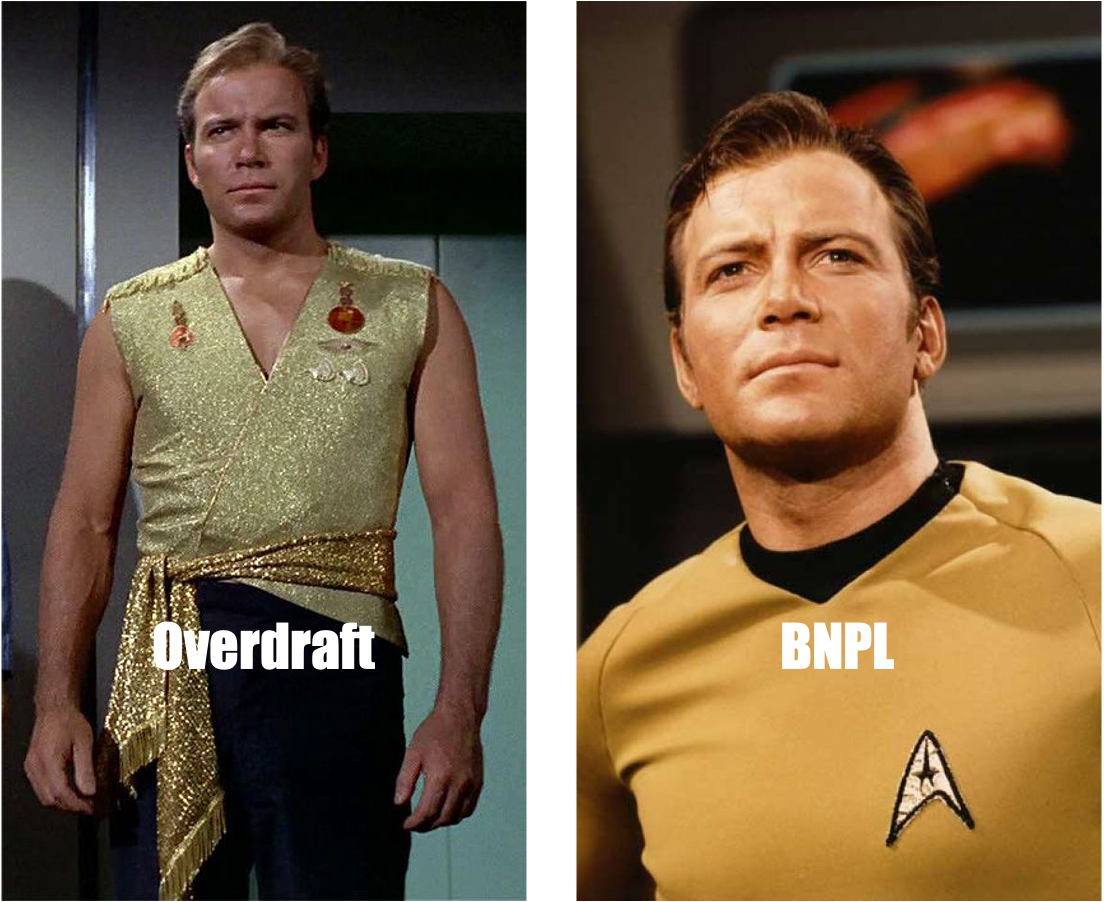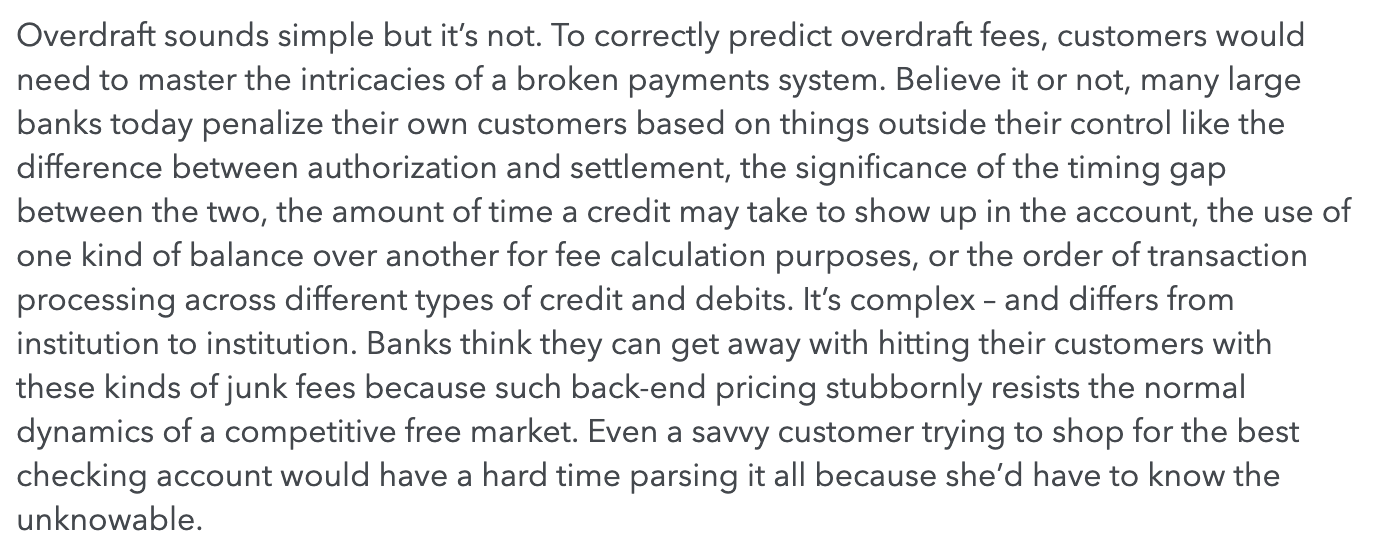BNPL is the New Overdraft
For now we see short-term liquidity through a glass, darkly.
Providers of Buy Now Pay Later (BNPL) loans love to bash credit cards.
Larry Diamond, Zip:
I think the reason that buy now, pay later has been so successful is it delivers a better and fairer alternative to the credit card
Nick Molnar, Afterpay:
we never wanted our consumers to revolve in debt, we keep our consumers’ best interests at heart
Max Levchin, Affirm:
I got my first credit card a couple years after coming to America and promptly destroyed my credit, because I had no idea how to use this power tool.
Dan Schulman, PayPal:
Twenty years from now, there will be no more credit cards, really
Sebastian Siemiatkowski, Klarna:
Those who can afford to pay off their balances each month reap rewards through loyalty schemes while those who can’t afford to simply get into more debt.
This anti-credit card positioning for BNPL has become so ubiquitous in the industry that it even showed up in the CFPB’s recent announcement that it was going to be investigating the surging U.S. BNPL market:
Today the Consumer Financial Protection Bureau (CFPB) issued a series of orders to five companies offering “buy now, pay later” (BNPL) credit. The orders to collect information on the risks and benefits of these fast-growing loans went to Affirm, Afterpay, Klarna, PayPal, and Zip. The CFPB is concerned about accumulating debt, regulatory arbitrage, and data harvesting in a consumer credit market already quickly changing with technology.
Lenders have touted BNPL as a safer alternative to credit card debt, along with its ability to serve consumers with scant or subprime credit histories.
Here’s the thing though — comparing BNPL to credit cards, while smart messaging for the BNPL providers1, isn’t all that useful for policymaking.
A more useful point of comparison would be another bank service; a service that, coincidentally, has also been in the CFPB’s crosshairs lately:
“Rather than competing on quality service and attractive interest rates, many banks have become hooked on overdraft fees to feed their profit model,” said CFPB Director Rohit Chopra. “We will be taking action to restore meaningful competition to this market.”
BNPL and overdraft are mirror images of each other; overwhelmingly similar and yet, in key ways, undeniably different.
In this post we’ll analyze some of those similarities and differences because, much like when Kirk and Mirror Kirk swapped universes, it’ll help broaden our perspective.
Through a Glass, Darkly: Comparing Overdraft & BNPL
Let’s start with overdraft.
Overdraft
Overdraft — the service that enables consumers to make deposit transactions in excess of their available account balances — started out as a simple courtesy that banks offered to customers who mistimed their check-writing and deposits.
From those humble origins, it has grown into a monster.
A number of factors — most notably the rise of debit cards and digital payments and the passage of the Durbin Amendment — helped overdraft evolve from a courtesy offered by banks to their most valued customers to a critical source of revenue paid primarily by their most desperate customers.
According to research from the CFPB, overdraft and non-sufficient funds (NSF) fees generated $15.47 billion in revenue for U.S. banks in 2019, which represented nearly two-thirds of banks’ total fee revenue. Previous CFPB research has indicated that a small subset of financially-vulnerable customers pay a majority of these fees (which average about $35 a pop), often as the result of mistakes or inattention rather than deliberate cashflow management strategies. According to previous studies, less than 9% of account holders have more than 10 overdrafts annually and pay close to 80% of all overdraft revenue. Recent analysis from the Financial Health Network sheds more light on exactly who these frequent overdrafters are:
low-to moderate-income households were nearly twice as likely to overdraft than higher-income households. Black and Latinx households with accounts were also far more likely to report having overdrafted than White households (1.9 times as likely and 1.4 times as likely, respectively), contributing to the disproportionate financial costs borne by people of color.
Additionally, we found that young people with checking accounts are more likely to overdraft than older people with accounts: 35% of those aged 18-25 had overdrafted, compared with just 7% of those 65 and older.
Furthermore, overdrafters are far more likely to have nonprime credit scores. Thirty-three percent of checking account holders with nonprime credit scores have overdrafted, compared with only 10% of those with prime credit scores. Among households with more than five overdrafts in a year, 80% don’t have prime credit.2
Not great, Bob.
But here’s some good news.
Competition from fintech companies (along with relatively steady pressure from regulators and lawmakers) has pushed banks to revamp their overdraft programs, to the benefit of consumers.3 You’ve heard about the big changes — Ally and Capital One eliminating overdraft fees altogether and big banks like PNC and JPMorgan Chase taking steps to reduce accidental overdrafts — but there has been a subtler, but more important shift playing out over the last decade. During that time banks’ overdraft revenue fell 57%, the percentage of regular overdraft users (those with 10 or more transactions annually) fell by 40%, and the size of the average overdraft increased from $50 to nearly $200.4
Looking forward, it’s easy to envision a market in which consumers have a plethora of different overdraft options — from banks and neobanks, both free and inexpensive — to choose from.
Now let’s hop universes and talk about BNPL.
BNPL
According to estimates from Cornerstone Advisors, consumer spend through BNPL grew from $24 billion in 2020 to nearly $100 billion in 2021. That growth, aided hugely by stimulus payments and the pandemic-fueled surge in e-commerce, was captured almost entirely by fintech companies like Affirm, Klarna, Afterpay, and PayPal, which (according to McKinsey) diverted $8 billion to $10 billion in annual revenues away from banks.
However, when we talk about BNPL we need to be precise. A lot of different lending models and businesses get lumped under the umbrella of BNPL. McKinsey helpfully outlines six of the most common models in the graphic below, including the one (integrated shopping apps) that I want to focus on.
Much of the growth in BNPL is due to the explosive growth that Klarna and Afterpay (and competitors like PayPal and Affirm) have seen in the use of their split pay or pay-in-4 products.
The way these products work is simple — a consumer is presented with the option (typically at the point of sale) to split their payment into 4 installments. The first installment (25% of the total transaction) is paid at the time of the purchase and the remaining three installments (of 25% each) are paid back in two-week increments (for a total loan term of six weeks). The loan is offered at 0% interest and typically comes with no fees (some providers charge late fees). The loans can be repaid via ACH, debit card, or (in some cases) credit cards and, if the loan isn’t repaid, access to loans from the BNPL provider in the future is often suspended.
As shown in the graphic above, pay-in-4 BNPL loans are most commonly used for smaller dollar transactions (less than $250), with 80%-90% of loans averaging between $100 and $110. A majority of the volume for these loans is sourced from higher-margin, discretionary-spend categories like apparel, footwear, fitness, accessories, and beauty. The typical pay-in-4 customer is young and either non-prime or credit invisible.5
Pay-in-4 BNPL providers make the majority of their revenue — projected by McKinsey to reach between $4 billion and $6 billion in 2023 — from the merchants they are integrated with, which pay fees ranging from 3% to 6% of each transaction.
As McKinsey observes in referring to Klarna and Afterpay as “Integrated Shopping Apps”, the future of pay-in-4 BNPL is moving beyond 1:1 merchant integrations to becoming comprehensive shopping destinations, as I noted in an article about Klarna a while back:
The strategic purpose of this shift is to eliminate Klarna’s dependence on its merchant partners for customer acquisition by converting first-time Klarna customers into highly engaged shopping enthusiasts that spend increasingly large amounts of their free time in the Klarna app.
The latest numbers reported by Klarna — 18 million monthly active app users globally and 3.5 million in the US — suggest that this strategy is succeeding.
Cultivating a large base of recurring shoppers allows Klarna and Afterpay to sell access to those customers back to their merchant partners via affiliate marketing and advertising programs.
Overdraft vs. BNPL Pay-in-4
So, how does overdraft compare to BNPL pay-in-4?
Let’s review:
Overdraft is increasingly happening on larger (and more intentional) transactions, becoming less expensive (or free), and generating less revenue for providers. BNPL pay-in-4 is mostly the opposite.6
Overdraft and BNPL pay-in-4 thrive in the same customer segments, but BNPL will arguably become more useful to those customers as BNPL providers begin furnishing to the credit bureaus.
BNPL pay-in-4 is obviously much less expensive for consumers than overdraft, but I do have concerns about the clear incentive that BNPL providers have to push consumers to shop and spend more than they can afford.7
BNPL pay-in-4 is designed to be far more transparent and intentional in its use than overdraft, which has relied on a lot of accidental usage and confusing pricing structures. This is beginning to change as banks modernize their overdraft programs, but they have a lot of ground to make up on this front.
Overdraft and BNPL pay-in-4 can both be difficult to manage, but in different ways.
For BNPL, the challenge is keeping track of payments (especially when using multiple providers). Two-thirds of BNPL users who have missed a payment in the last two years said it was because they lost track of when the bill was due, according to Cornerstone Advisors’ survey data.
And for overdraft, the complexity stems more from the U.S.’s antique payments infrastructure, as the CFPB’s Rohit Chopra notes:
Not New, But Different
A mirror universe — in which we see similar, yet intriguingly-different versions of the characters we know — is a compelling storytelling device. It’s also a useful analogy for those of us working in financial services. There are very few truly new ideas in banking, just old ideas with new and interesting twists.
Overdraft and BNPL pay-in-4 fundamentally serve the same customer need — short-term liquidity for consumers with cashflow imbalances and a lack of access to mainstream credit products. The twist with BNPL pay-in-4 is that it shifts the cost of this short-term liquidity from consumers to merchants. This innovation is a potentially promising development, but also introduces new incentives that deserve thoughtful scrutiny.
As the CFPB (and other regulators) dig into these areas, I would strongly encourage them to think holistically rather than in silos. If for no other reason, it may lead to some compelling plotlines for a television show in the future.8
Sponsored Content
Fintech Meetup, the world’s largest fintech meetings event, is just 70 days away! There are no speakers or fireside chats…just 30,000+ virtual meetings that fill your pipeline with new leads, partners and opportunities. Meet 3,000+ participants from Fintechs, Major Banks, Neobanks, Regional & Community Banks, Credit Unions, Investors, Networks, Solution Providers, Tech cos, Retailers & Merchants and many others! Virtual, March 22-24. Get Ticket Now.
Short Takes
BNPL Cashback
Affirm launched a way to earn cashback rewards on its buy-now-pay-later purchases. And Afterpay partnered with Rakuten to launch its own cashback rewards.
Short take: No wonder everyone is so confused! BNPL companies keep finding new ways to make their products seem like credit cards (but better). In this case, it’s adding cashback rewards. The interesting twist here is that the cashback is provided on an individual merchant level through offers made in the BNPL providers’ apps. Compared to regular old credit cards, I could see merchants preferring this option. We’ll see what consumers think.
Churn that Butter
Butter, a platform that prevents customer subscription payments failures, raised $7 million.
Short take: First, great name. Makes headline writing easy. Second, this is another reminder of just how much extra value is waiting to be wrung out of the subscription economy. Companies like Pipe are turning subscriptions into upfront revenue. Butter is turning the problem of accidental subscriber churn into a wedge product for a new payments infrastructure company.
Betrothed Now, Pay Later
Carats & Cake, a point-of-sale financing solution for venues and property groups, raised $19.3 million.
Short take: Given that weddings have been on a decades long streak of becoming more elaborate and expensive (at least according to my parents), I can see the appeal of BNPL for wedding venues. That said, I have questions about this one. For example, Carats & Cake says on its website that it doesn’t pull consumers’ credit files to underwrite its split pay loans, but that seems odd (and maybe risky) given the size of the overall transaction?
Research Corner
🚨New research alert🚨
Ron Shevlin and I teamed up to create The Definitive Guide to Potentially Misunderstood Fintech Trends & Terms (and what they mean to the banking industry).
You’re going to want to download this report (which you can do here), trust me. It’s got all the fintech buzzwords you love to hate — super apps, open banking, embedded finance — and plenty of snark and (dare I say) insight.
Alex Johnson is a Director of Fintech Research at Cornerstone Advisors, where he publishes commissioned research reports on fintech trends and advises both established and startup financial technology companies.
Twitter: @AlexH_Johnson
LinkedIn: Linkedin.com/in/alexhjohnson/
Positioning oneself as the “anti-credit card” is never going to be a bad marketing strategy. As I’ve written before, credit cards are insidiously bad products.
The point about non-prime (and credit invisible) consumers using overdraft more frequently is particularly troubling when you consider that banks don’t report overdraft repayments to the credit bureaus, thus making overdraft a form of short-term credit that has no potential to help consumers establish or build positive credit histories.
Also worth noting — failing to repay overdrafts can still hurt consumers if they are sent to collections (which does show on credit reports) and/or if they end up as a negative data point in ChexSystems (don’t get me started).
For the Star Trek fans, the influence of fintech on banks’ overdraft programs is like the influence that Kirk had on Mirror Spock when he told him “I submit to you that your Empire is illogical because it cannot endure. I submit that YOU are illogical to be a willing part of it.”
A note of caution — you should treat all studies and research into overdraft with a grain or two of salt. The CFPB studies and the study from Curinos (done at the behest of the Consumer Bankers Association) were done with very specific aims in mind. What they’re telling you is true … from a certain point of view.
Like overdraft, pay-in-4 BNPL loan repayments aren’t typically reported to the credit bureaus. This is starting to change (hi Equifax!), but it’s unlikely that BNPL will meaningfully help consumers build their credit histories in the immediate term.
Remains to be seen if BNPL pay-in-4 becomes less expensive for merchants. Competition is driving price compression, but BNPL providers are actively working to counter that compression through new value-added services like affiliate marketing.
Unlike overdraft, there is absolutely no public or regulatory pressure for BNPL providers to lower their merchant fees. Maybe someday merchants will band together and lobby for the BNPL equivalent to the Durbin Amendment.
You could argue that banks, historically, have had a similar incentive to encourage overdrafts. The difference is that they haven’t been as deeply integrated into the shopping experience as BNPL is.
If any of you would like to get together and pitch story ideas for a potential bank/fintech/crypto regulation TV show, let me know and I’ll pull together an informal virtual writers’ room.







